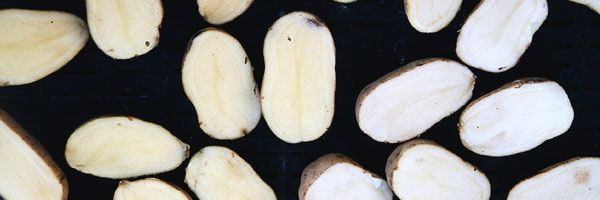
White flesh and immature tubers
Symptoms
- Internal:
When the tuber is cut open the colour of the flesh is seen to be very pale, usually white but not glassy. This pale colouration may concern a whole potato lot, a batch (photo 1) or sometimes only a few tubers, or even only parts of the tuber (photos 2 to 4).
- External:
White-fleshed tubers sometimes have a finer skin, sometimes even loose skin and are more prone to rot, wounds and thumbnail cracks on the surface of the tuber.
When seed tubers are affected, their ability to germinate may be diminished, particularly in cold conditions in spring and irregular emergence of the plants may occur. If hot conditions occur during the growing period, the seeds may rapidly liquefy and weaken the plant which will then be more susceptible to disease (Pectobacterium for example).
- Risk factors
This phenomenon, which is mainly observed in certain cultivars, appears to be attributable to various factors. In particular immaturity due to a too early haulm destruction or conditions favouring growing stress: light soils, overly rapid growing cycle, excessive nitrogen, second tuber formation in the case of the small size tubers, etc.
- Control measures
Prevention basically consists of reaching adequate tuber maturity before haulm destruction and cultivation methods that reduce growing stress (appropriate fertilisation and irrigation, etc.).





